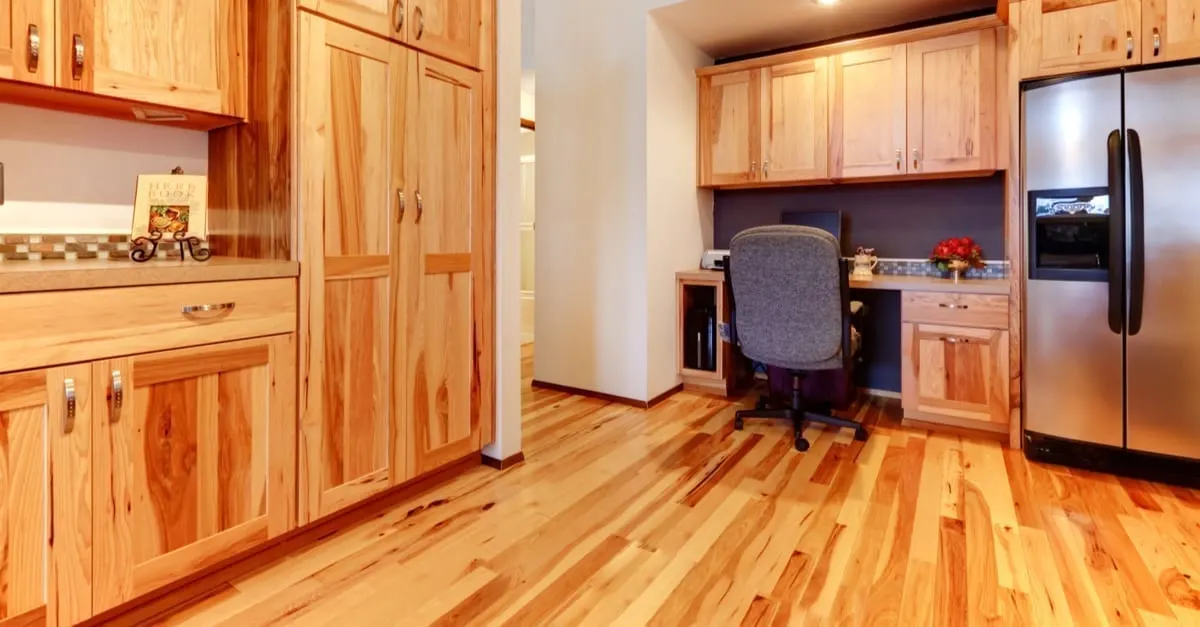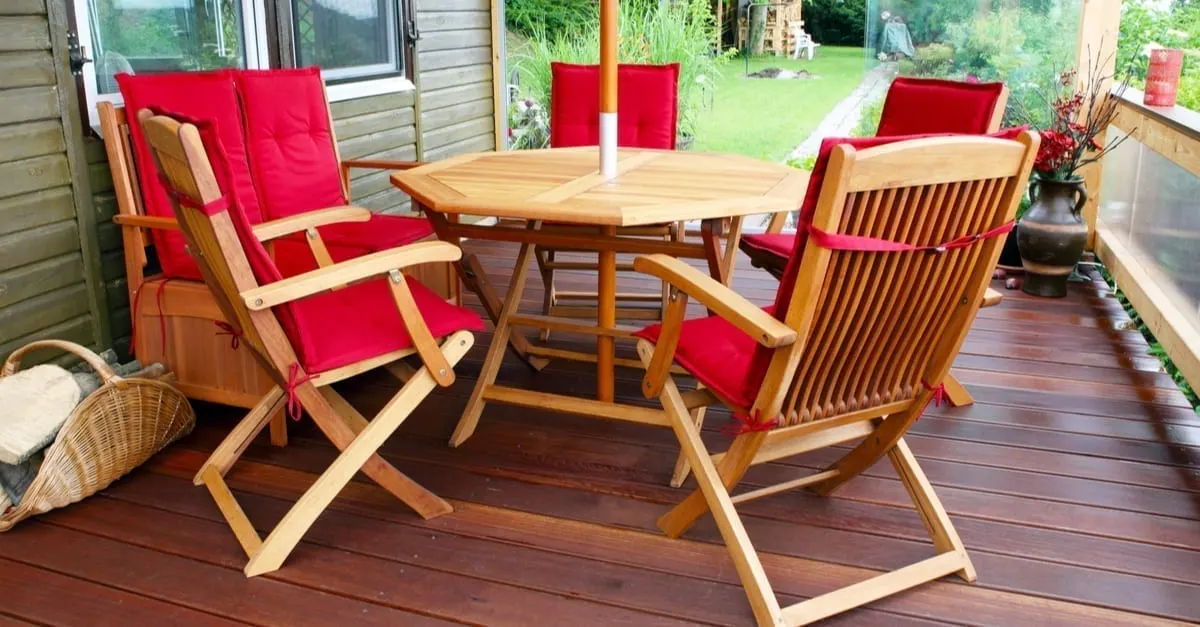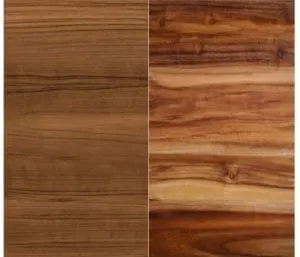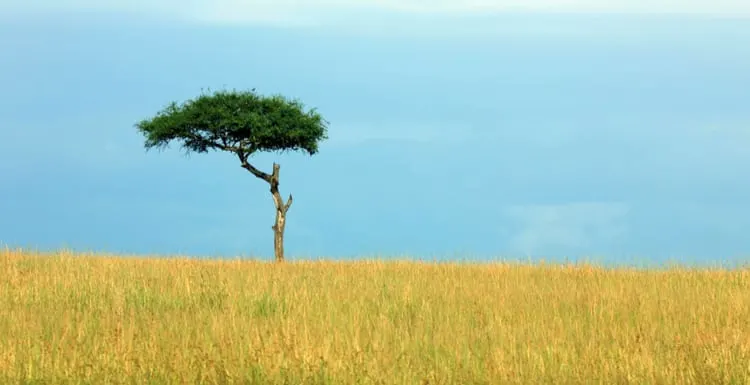If you’re planning to refinish your floors, be sure to consider acacia wood.
After all, it’s less expensive than teak but offers similar benefits. Read on to learn more about this unique type of wood.
What Is Acacia Wood?
Acacia wood is a popular, durable, and sustainable exotic hardwood that is often used as an alternative to highly sought-after teak wood. The wood is taken from any of several thousand species of acacia trees and shrubs.
Acacia trees and shrubs are scattered around the world, but they primarily grow in Australia and Africa. The name acacia comes from the Greek word ἀκακία, meaning “thorny Egyptian tree.”
It’s also known as thorntree, Asian walnut, whistling thorn, and wattle. Acacia trees and shrubs are in the same family as the Mimosa tree.
What Does Acacia Wood Look Like?
Acacia wood is usually reddish-brown in color, but the color varies quite a bit, even within a single tree or shrub. You can find acacia wood in colors ranging from a light amber tint to a dark mahogany hue.
The grain patterns in this wood can be nearly straight or wavy. The wood usually contains a high number of knots due to the high number of branches that grow from acacia trees and shrubs.
Considering the variations in color and grain patterns, no two pieces of wood are identical. It’s a truly unique wood.
More Acacia Wood Facts
- Several species will fluoresce, or appear to glow, under a black light. If you’re ever unsure if a wood is truly acacia, shining a black light on it can help you determine if it’s really acacia wood.
- Carl Linnaeus, a Swedish botanist, first found and classified the acacia tree on a discovery expedition to Africa in 1773. He called it the “thorn of the Nile.”
- Acacia is commonly used in Hawaii, where it’s a native species (Acacia koa). There, it’s used to make everything from canoes to ukuleles.
- Some species of acacia grow full, sturdy thorns. In Belize, Costa Rica, Guatemala, and El Salvador, these acacia thorns are used to make jewelry and unique souvenirs.
How Acacia Wood Is Used
Acacia is a common alternative to the more expensive teak wood. Its strength and durability help it hold its shape without shrinking. It stands up to regular use without scratches or damage.
Acacia can be used in several ways throughout the home. Some of the most common uses are:
- Flooring (solid wood or engineered)
- Furniture (especially outdoor furniture)
- Functional decorative items, like plates, serving utensils, and bowls
- Instruments like ukuleles, flutes, and violins
- Boat-building, especially in Hawaii and the Philippines
- Artistic wood pieces
Acacia Wood Flooring

Artazum/Shutterstock
Because acacia wood is commonly used in flooring, it’s worth discussing the strengths and weaknesses of using this hardwood underfoot. There are two types of acacia wood flooring: solid and engineered.
Solid acacia flooring features solid, cut planks of acacia wood. Engineered acacia flooring is less expensive because it uses thin veneers, or layers, of acacia wood over an inexpensive plywood base. Read more about the cost of acacia wood under the Acacia wood cost section below.
The acacia species you’ll see used in flooring (and furniture) most often is Acacia melanoxylon. This species is highly durable, water-resistant, and easy to maintain long-term. It rarely, if ever, needs to be refinished.
Even long-term sun exposure won’t bleach or change the finish of acacia wood. This is why it’s so often used in outdoor furniture.
Acacia Wood Furniture

Fotoknips/Shutterstock
The strength, beauty, and fine-grain smoothness of acacia wood make it a popular choice for furniture. Most often, you’ll see acacia wood used to make dining tables, living room furniture (couches, chairs, and coffee tables), beds, and consoles.
Acacia wood furniture is nearly indistinguishable from teak. This is one reason you might use a black light to check for fluorescence (as mentioned above): sometimes, sellers label acacia wood products as teak to fetch a higher price.
Acacia Wood Pros and Cons
Acacia wood boasts a lot of benefits that make it a popular choice for those looking for exotic hardwood flooring or furniture options. But it’s not without its limitations. Let’s look at the pros and cons of this wood in flooring and furniture.
Pros: Durable, water-resistant, strong, unique, lightweight, sustainable, and affordable
- Durability. It’s harder than maple and mahogany, making it extremely durable and resistant to scratches and damage.
- Water resistance. It resists damage from water, mold, and even fire (but note that it’s not water-, mold-, or fire-proof).
- Strength. It’s a sturdy hardwood that can hold a lot of weight, which is why it’s often used for tables and shelving.
- Unique. Every piece of wood looks a bit different because of the nature of the wood. It’s full of knots, and the grain pattern varies widely.
- Sustainability. Acacia is a sustainable wood because the trees and shrubs grow so quickly. Those harvested for use can be quickly replaced.
- Lightweight. Compared to other hardwoods, this alternative is lightweight. It can hold many times its weight.
- Affordability. Sustainability makes it less expensive than similar woods like teak. As a highly renewable resource, more trees and shrubs are available at a given time, reducing the cost compared to woods like teak.
Cons: More expensive than common hardwoods, limited availability, short planks, prone to defects, susceptible to warping, requires some maintenance, can’t be exposed to certain substances
- More expensive than common hardwoods. While it’s more affordable than teak, it’s still more expensive than common hardwoods like oak and maple.
- Limited availability. Acacia trees and shrubs are plentiful and are not endangered, but they are not as widely commercially available as hardwoods like oak, maple, and cherry.
- Short planks. Most acacia trees and shrubs don’t reach great heights, so the planks taken from them are usually short. For flooring, especially, this can be an issue.
- Prone to defects. Every piece of acacia will have a different wood grain appearance, color, and texture, so if you want a uniform look, this isn’t the choice for you.
- Susceptible to warping. While it’s regarded as being water-resistant, it is not waterproof. Leaving untreated solid acacia furniture or structures exposed to repeated rain, moisture, or snow will eventually cause them to warp and swell.
- Requires some maintenance. Unfinished acacia wood must be waxed to keep moisture from getting in. Without waxing, unfinished acacia wood is prone to cracking. Note: Finished Acacia wood should never be waxed.
- Can’t be exposed to certain substances. Perfumes, alcohol, detergents, extreme temperatures, scouring pads, and silicone-based products will damage acacia.
While there are both pros and cons, it’s worth considering acacia wood for both your home and furniture.
Acacia Wood Prices
Acacia wood isn’t expensive, but it’s certainly not cheap. As a moderately priced exotic hardwood, you can expect to pay the following amounts when you purchase acacia wood flooring or furniture:
Wood Flooring
- Solid flooring: $3 to $8 per square foot
- Engineered flooring: $2 to $6 per square foot
Wood Furniture
- Dining tables: $300 to $700+
- Living room consoles: $150 to $350+
- Couches or sofas: $300 to $800+
- Chairs: $50 to $300+
Wood Items
- Bowls: $10 to $60+ for set of 4
- Plates: $20 to $45+ for set of 4
- Shelves: $20 to $60+
Acacia continues to command moderate to moderately high prices because of its unique, attractive wood grain features. With these pricing averages in mind, let’s look at how this wood actually compares to the more expensive teak.
Comparison: Acacia vs. Teak
In the below image, teak wood is on the left and acacia wood is on the right. You can clearly see how the grain and color are much richer in the piece of wood on the right.

Wk1003mike/Greg Brave/Shutterstock
Woodgrain
- Acacia features more variety in color and in wood grain than teak. The wood’s grain varies from nearly straight lines to curvy, undulating waves. Teak’s grain patterns don’t differ as much; they usually feature almost-uniform, straight lines.
- On the other hand, because acacia wood grain has curvy or interlocking grain patterns (lines that overlap), it’s easy to shear, or mar, these grain lines when the wood is being cut. Teak does not have this problem with its dense, straight grain.
Color and Aging
- Acacia wood is usually somewhere on the continuum of reddish-brown, but it varies wildly. The color will not darken with age unless it is exposed to extreme outdoor conditions or certain chemicals.
- In teak wood, the light brown color will naturally fade over time, no matter what conditions the wood is exposed to.
Desirability
- Teak is the wood that is more commonly used in high-end furniture and flooring. It seems to have a more “exclusive” reputation than acacia, which is still thought of as a cheaper alternative to teak.
Functionality
- Acacia has to be finished or coated with wax to increase its durability. Still, teak is naturally durable because of its natural oils; it does not require a top coat.
- However, this is a better candidate for staining and other wood treatments. Teak doesn’t accept them as readily due to their high content of natural oils.
- The oils in teak also make it less likely to crack or change shape over time than acacia.
Commercial Availability
- Acacia is a bit easier to find commercially because of its lower cost. Teak is not rare or hard to find, but many chains and commercial outlets may not carry it because of its expense.
Eco-friendly
- Acacia is widely regarded as the more sustainable, eco-friendly choice for flooring and furniture because it is a highly renewable resource. The fast-growing trees and shrubs don’t get very tall, so the time from plant to harvest is much shorter than with teak.
The Final Word on Acacia Wood
Acacia wood is durable, affordable, and attractive. It is a sustainable choice for flooring and furniture, and the unique wood grain makes it an appealing option for homeowners looking to add visual interest indoors or outdoors.
For hardwood floors, acacia wood is a moderately expensive option that is less common than oak or maple and less expensive than teak.
For furniture, the high strength and durability of acacia—as long as it’s kept in the right conditions—make it a wise choice.
Compared to teak, acacia is a better option for budget-conscious homeowners who want the look of teak but like the price and sustainability of acacia.
However, if extreme durability and strength are the primary goals, teak is the better choice. How are you using acacia in your home? Do you like it as an alternative to teak?

